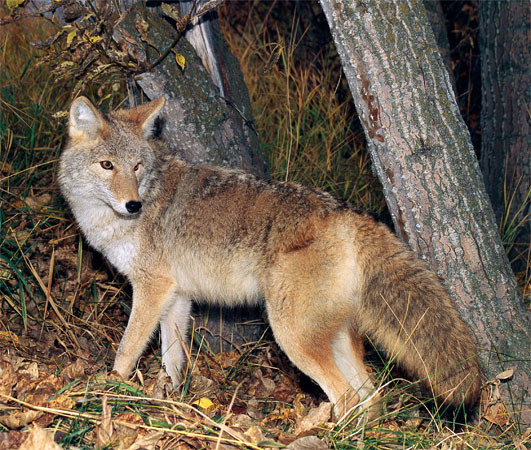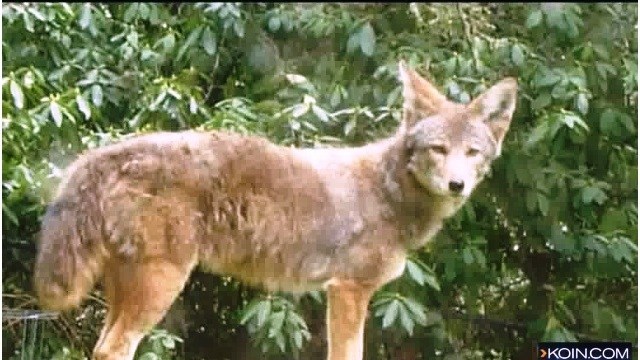
The coyote (Canis latrans) is a widely distributed dog-like carnivore that can be found in virtually all of North and Central America. It is generally a slender animal, very similar in appearance to a medium-sized dog and since the coyote and domesticated dog are from the same family, Canidae, the resemblance is more than a coincidence. Coyotes have a bushy tail which is usually tipped in black and is carried down at a 45 degree angle as the animal moves, unlike that of its other cousin the wolf. The majority of coyotes are gray, though some show a rusty, brown or off-white coloration. It stands about one and one half to two feet tall and is between 41 to 53 inches in length. Males of this species are larger than the females and weigh anywhere from 20 to 50 pounds. Resembling a skinny German Shepherd, this member of the wolf family can run 45 miles per hour in short bursts; and the male coyote’s range can encompass up to 36 square miles. Their presence in fields and their haunting calls at night seem to be ever more prevalent around Ohio, these days.
Although the coyote is not native to Ohio, it is present throughout the state today, when in fact, they have been in Ohio for more than 60 years. The first confirmed coyote specimen in Ohio was taken from Preble County in 1947. Love or hate it, the coyote has the ability to make the best of a bad situation to survive or even prosper. Usually, we associate the coyote with the open, deserted lands of the west. As its presence in Ohio shows, this versatile animal can make a home most anywhere.

Native American folklore is filled with tales of the coyote. This animal is either revered for its intelligence and ability to resolve a conflict or threat to its life or is frowned upon for being a cunning and deceiving manipulator, much as it is thought of in real life.
Both a much maligned and admired creature that slinks about the Ohio landscape, it has earned the title of “trickster” in many American Indian tribes due to its cleverness. On the other hand, for many farmers, the coyote is nothing more than a thief in the night lurking in dark corners but especially active at dawn and dusk.
These wild dogs have proliferated in the Buckeye state and there are now sizeable coyote populations in all 88 counties, according to Ohio Department of Natural Resources. Farmers and livestock producers are taking note, as there is constant talk over what impact this surge in coyote numbers will have on livestock predation, family safety, and the state’s wildlife populations.
Coyotes are prospering and are perhaps feeling more emboldened because of a lack of human pressure, as coyote complaints are common from hunters, pet owners, and livestock producers alike. Coyote hunting in Ohio is legal year round and if coyotes are nuisances and annoyances in the area, hunters should consider trying coyote calling in the spring and summer and send the pack packing.
There is no specific, open season for hunting coyote, as well as no daily bag limit. However, the primary argument against attempting to remove coyotes from an area is based on the facts of coyote reproduction and behavior. In areas where there have been reductions in the coyote population due to human efforts, coyotes typically increase their litter size until the population is again brought up to the level that the habitat can sustain. In addition, empty territories attract coyotes that migrate to fill in the void.
Now all that being said, is the coyote the farmer’s friend or foe? They might be great groundhog hunters, freeing the fields of that destructive varmint, however, they can wipeout the spring lamb crop, the free-range chicken flock, as well as the feline “mouse-ing” machines found in every farmer’s barn. You tell me, friend or foe?